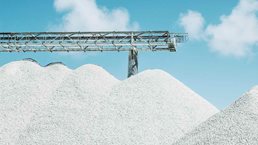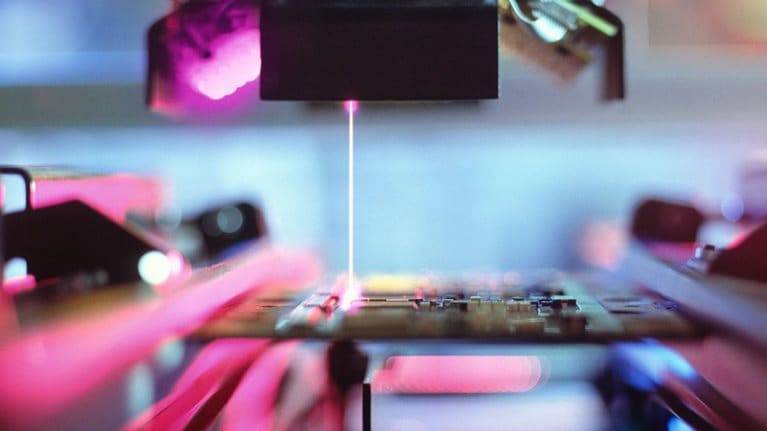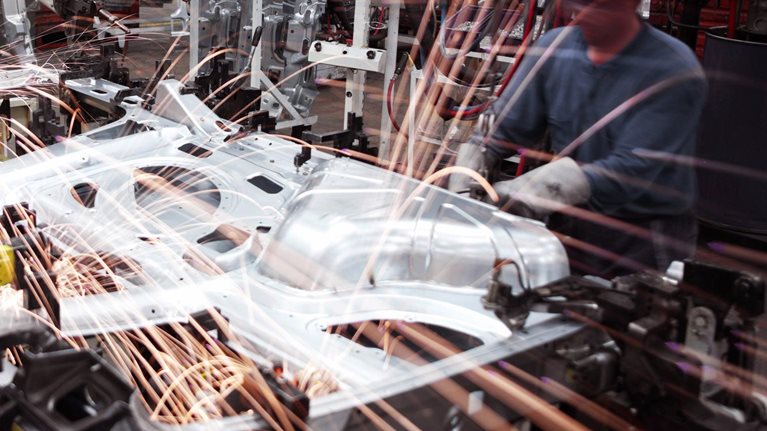The global mining industry is under pressure. In the short term, falling commodity prices are squeezing cash flow. Looking ahead, many existing mines are maturing, resulting in the extraction of lower ore grades and longer haul distances from the mine face; ore-body-replacement rates are in decline; and new-mine-development times are increasing. On top of this, worldwide mining operations are as much as 28 percent less productive today than a decade ago—and that’s after adjusting for declining ore grades.1
The industry has shifted its focus to improving productivity by “sweating” existing assets, but this strategy will go only so far. Despite the industry’s booms and busts, the nature of mining has stayed the same for decades. Achieving a breakthrough on productivity performance demands rethinking how mining works.
The potential to achieve such a breakthrough is now coming within the industry’s reach through digital and technology innovations that could transform key aspects of mining. In this article, we describe a number of digital technologies that have long been in the works and are now available and affordable enough to become operational at scale across the mining industry. Their applications include building a more comprehensive understanding of the resource base, optimizing material and equipment flow, improving anticipation of failures, increasing mechanization through automation, and monitoring performance in real time.
Alone, each of these opportunities has real potential; together, they represent a fundamental shift in both potential safety outcomes and how value can be captured in the mining sector. We outline these opportunities and raise several key questions that miners should ask themselves as they navigate the journey.
The productivity imperative
Our analysis shows that global mining productivity has declined 3.5 percent a year over the past decade (Exhibit 1). This trend is evident across commodities, geographies, and most mining companies.

While there is debate about the cause of the decline, there is universal agreement that this performance is untenable. As the industry outlook has deteriorated, most mining companies have shelved or trimmed expansion plans and refocused on doing more with less. The result has been that mining productivity has leveled off and even started to recover in some locations and commodities.
But there remains significant untapped potential for productivity improvement. One way to understand the order of magnitude is to compare mining to other industries such as upstream oil and gas, steel, and oil refining. Based on our benchmarking, we observe a global average overall equipment effectiveness (OEE) performance of 27 percent for underground mining, 39 percent for open-pit mining, and 69 percent for crushing and grinding—compared with 88 percent for upstream oil and gas, 90 percent for steel, and 92 percent for oil refining.
Discover how MineLens can provide data and insights to optimize mining productivity
Of course, mining differs from other industries in many ways. It is highly variable, starting with uncertainty about the nature of the resource being mined. Mining operations often take place in extreme environments and in far-flung locations. Moving operators to the work site (whether by flying them in, moving them underground, or from shaft to face) can consume valuable time in itself. And the strains and stresses placed upon mining equipment by rocks of unpredictable size and hardness result in frequent breakdowns.
But this is exactly the point. Smart planning and coordination of activities are required to mitigate variability caused by external forces; disciplined execution is needed to eliminate variability that miners create themselves. The path to a step change in mining productivity will come through reducing and, where possible, eliminating the variability that has made mining unique.
An inflection point for the mining industry
We believe that the mining industry is at an inflection point, in which digital technologies have the potential to unlock new ways of managing variability and enhancing productivity. The large-scale adoption of four different clusters of technologies is accelerating2 :
- Data, computational power, and connectivity. Embedding vast numbers of sensors in physical objects—churning out large volumes of data for analysis and enabling communications among machines—is increasingly affordable and accessible. Smart grids can report power usage across millions of homes; sensors on remote deep-sea oil wells cause warning signs to flash at the central control center when problems arise. In 2015, more data are generated every day than existed in total through 2003. Miners already produce huge amounts of sensor data, potentially enabling them to obtain a more accurate and consistent picture of reality at the rock face than ever.
- Analytics and intelligence. Advances in analytics, from machine learning to improved statistical techniques for integrating data, help turn vast data sets into insight about the probability of future events. Telecommunication companies, for example, use smart algorithms to predict customer churn; retailers employ them to aim offers at customers. Complex mining tasks such as geological modeling, on-the-day scheduling, and predictive maintenance are increasingly in the domain of smart statistical and optimization algorithms.
- Human–machine interaction. Consumer smartphones and other mobile devices have transformed the way that people interact not only with one another but also with machines. Consumers rely on their smartphones for driving directions, booking taxis, and monitoring their health; applications are also spreading rapidly in the industrial field. One example is “smart” glasses or goggles that feed instructions to workers working on an assembly line or to a worker carrying out repairs on equipment, improving operating disciplines. Another is work clothing that incorporates sensors transmitting data to managers about hazardous conditions and the physical condition of the workers themselves, improving safety outcomes.
- Digital-to-physical conversion. Advances in robotics are making equipment that is fully autonomous more affordable and effective. In manufacturing, the cost of industrial robots has fallen by 50 percent since 1990, while US labor costs have risen 80 percent over the same period. Meanwhile technological advances in areas such as artificial intelligence are increasing the sophistication of robotics and expanding their productive applications.3 In mining, the use of teleremote and assisted-control equipment is becoming common, and deployment of fully autonomous equipment is taking hold in haulage, drilling, and other processes.
Taken together, these technologies enable a fundamental shift in the way mining works—a shift marked both by harnessing the flow of information to reduce variability in decision making and by deploying more centralized, mechanized operations to reduce variability in execution.
The next performance horizon
Our view is that the greatest impact will come from embedding these technologies as an integrated whole across the mining value chain. We see five areas of significant value creation (Exhibit 2):

- Deeper understanding of the resource base. Few questions excite mining executives as much as this one: What if you knew exactly what was in the ground and where? The journey of developing resource insight from exploration to short-term mine planning is often scattered across organizational boundaries, data sources, and different geological models. Today, miners can gain much better resource knowledge by combining ore-body model information with blast-hole drill data and online sampling. Statistical techniques to make sense of exploration data have the potential to improve the probability of discovery and help target further drilling to maximize information gains. The integration of geological information into one better, universal source of truth helps optimize drill and blast patterns, create an executable mine plan, and avoid quality issues at the source. With these enhancements, traditional activities such as core logging, face inspections, and manual plant assays will no longer be required (Exhibit 3).

- Optimization of material and equipment flow. In essence, mining supply chains are interdependent systems of multiple pieces of fixed and mobile equipment. Tools and metrics such as OEE are a sound basis for operational improvement but fail to grasp system complexity. Real-time data and better analytical engines are making possible the scheduling and processing decisions that maximize utilization of equipment and yields. One example is in the mine pit, where combining traditional dispatch with smart algorithms can optimize machine movements for maximum efficiency. Another is in processing plants, where our work suggests that many plant operators have blind spots in understanding the drivers of yield. By applying new mathematical techniques that look for hidden relationships between second- and third-order variables, we have found that plant yields of gold, nickel, phosphate, and other processed minerals can often be improved by 3 to 10 percent within months (see sidebar “How advanced analytics helped a gold mine to step up performance”).
- Improved anticipation of failures. Mining companies typically collect huge amounts of data from drills, trucks, processing plants, and trains. Yet rarely is this information used to generate insight; in some cases, miners use less than 1 percent of the information collected from their equipment (Exhibit 4). Deploying this information to estimate the probability of failure of specific components—rather than using a traditional time-based approach—helps reduce maintenance spending and prevent unplanned interruptions that cost metric tons (see sidebar “How a mine cut maintenance costs and improved equipment availability using advanced analytics”).

- Increased mechanization through automation. Automation offers the potential to reduce operating costs, improve operating discipline, and take people out of harm’s way. Some technologies, notably automated haulage and drilling, have moved into full-scale commercialization, while others, particularly automated blasting and shoveling, are in testing. Our analysis suggests that the economics of haulage are sound—reducing total cost of ownership by between 15 and 40 percent, depending on the cost of labor—although miners must manage several design choices around pit configuration, equipment configuration, and operational transitions. Furthermore, our work on developing automated mining operations has identified opportunities to reduce the number of people working in areas considered most dangerous by more than 50 percent (see sidebar “Mining the unmineable: How digitization is paving the way for a mining company to move far beyond historical frontiers”).
- Monitoring of real-time performance versus plan. One benefit of real-time data is knowing the state and location of every piece of equipment in a mining operation at every second—and, in particular, whether it is operating according to or outside of the plan. This real-time insight gives new meaning to operations performance management, taking the conversation from one about monthly output to one that focuses on variability and compliance to plan. Furthermore, connecting this real-time feed to a central operating center not only makes possible a real-time response but also moves control to a more sophisticated decision-making capability at the center that can take actions to optimize operations across the whole supply chain, rather than local silos. This capability can be deployed both to improve safety outcomes by detecting deviations from expected operating conditions and to maintain high equipment utilization and low operating cost consistent with operating plans.
Each opportunity is significant in itself, but achieving the full potential of all opportunities is possible only if they are pursued in an integrated fashion. We see three reasons for this.
First, the physical technology required for automation provides the real-time flow of information that forms the foundation for better insights. Investments in automation are best done alongside investments in systems and tools that build a foundation for better decision making.
Second, in time, these decisions will be fed back to autonomous machines, not to human operators. The real value of completing this loop will be in the learning it provides—consistently recorded decisions and actions that, working with machine learning algorithms, will be continuously refined to get better with every iteration.
Last, once part of the system exists on a digitized platform, there are real benefits, or network effects, to extending it across the supply chain. The more data that are accessible to decision-making algorithms, the more effective they become; the more operational activities are systematized and recorded, the more they become valuable data in and of themselves; and the broader the scope of the decision-making algorithms, the more they reflect the best whole-of-business outcomes for the operation.

Would you like to learn more about our Metals & Mining Practice?
A fully integrated and automated mining supply chain may not be universally realized in the near future, but it is more than mining science fiction—it is the logical end point in a series of technology deployments that mining companies have already initiated. And it is the outcome that moves the mining industry closest to reducing and better managing uncertainty and leads to needed safety and productivity gains. Thus, we see it as a natural destination; the question is how long it will take to get there and to navigate the journey successfully.
Navigating the journey
Capturing the value from digital innovations represents a fundamental shift in vision, strategy, operating model, and capabilities in the mining industry. In particular, much of the value creation in mining will shift from how well the operation moves material to how well it collects, analyzes, and acts on information to move material more productively. This will be a difficult change, and it will only succeed if industry leadership believes there is a big prize at the end of it. Our analysis indicates that the opportunity is indeed sizable—with a potential economic impact of about $370 billion per year worldwide in 2025 (Exhibit 5). This would amount to 17 percent of the projected cost base of the industry globally in 2025.

The key to unlocking this value will be to see innovation as an undertaking that encompasses all aspects of the business, rather than a technology effort. In truth, most of the technology challenge has been solved. This makes capturing the opportunity a management challenge for the next generation of industry leaders. We see a number of factors that will drive success:
- Is technology seen as an end in itself, or is this effort firmly grounded in value creation? Miners must resist the temptation to pursue intelligence at the expense of value. It is difficult to set up a department that can integrate business problems and the practical application of technologies. The key to doing so is to have cross-functional teams that understand both mining operations and the technologies, and to integrate new technologies into operations and measure their impact.
- Is technology seen as the next generation of bigger and better gear, or a more fundamental shift in the operating model? Approaching technology as the next generation of gear to reduce direct head count could lead to missed opportunities to integrate real-time data with decision making. The task of integrating data into decision making across central planning and local sites, and across the full breadth of operations from pit to port, is making miners more akin to system engineers than movers of dirt. Mining companies must be able to get the systems-integration skill set right to maximize value creation.
- How effectively are the people changes managed, both the shift in culture and the change in capability mix required to deploy new technologies? From our work on big data across industries, we know that technology—data, analytics, and systems—is only part of the answer. Changes are needed in processes and people to most effectively implement technology and the new ways of working that it makes possible. Successful miners will set an integrated vision from data to systems to core processes to people capabilities, recognizing that new technologies only create value if they change the way people work and make decisions.
- How well does management do at the start, balancing wins over 12 to 18 months to build momentum with a longer-term vision of where the company is headed? The concept of two-speed innovation—an agile approach to going after the most accessible big-ticket items, combined with a more measured approach to changing core systems and architectures—is now commonplace. The approach to applying new technologies in mining must follow the same principle. A priority is placed on achieving wins in the near term to show value and build the capabilities necessary to extract value from technology. At the same time, the legacy control systems, IT systems, and data architecture of many mining companies need a comprehensive transformation to support deployment of the new technology at scale. Successful players will find ways to do both.
- How well does the organization adapt to the new set of opportunities? At many mining companies, there is often no executive designated as the clear owner of innovation. Furthermore, going after this opportunity with the existing capability set or by using the current scorecards, metrics, and budgets will likely result only in a continuation of the status quo. To make these changes happen, mining companies must adapt their organizations by creating clear ownership among the top executive team, refining the organizational design to create meaningful senior roles for people with technical skills, and redesigning the annual planning and performance-management process to create space for innovation.
Mining has always been marked by uncertainty and variability, from the resources in the ground to the stress on equipment to the weather. These dynamics are core to the industry’s operational performance. The key to the next era in mining is recognizing that this situation is no longer inevitable—that, with the right investments, miners have the opportunity to reduce and, in some cases, eliminate the uncertainty. Over time, mining work will evolve toward knowledge-based jobs that solve the same challenges as today but do so through different means. The mining companies that recognize this shift today and best navigate the changes ahead will be the winners of tomorrow.


